Estonia
 From Rationalwiki
From Rationalwiki _-_EST_-_UNOCHA.svg.png)
“”Never in the course of centuries have the Estonian people lost their ardent desire for Independence. From generation to generation Estonians have kept alive the secret hope that in spite of enslavement and oppression by other nations the time will come in Estonia "when all splinters, at both end, will burst forth into flames".
|
| —Estonian Declaration of Independence, 1918.[1] |
The Republic of Estonia (Estonian: Eesti Vabariik ) is a small democratic country located on the Baltic Sea in northern Europe. It is the northernmost of the Baltic countries. It's notable for its high levels of digital advancement, low levels of religiosity and the country also stands out with Europe's largest gender pay gap,[2] and digital developments have also slowed down in recent years. In 2022, the European Commission criticized Estonia for unsatisfactory internet connection in rural areas.[3] Estonia's capital and largest city is Tallinn.
The territory of Estonia has been inhabited since at least 9,000 BCE, with its people forming nomadic communities in the region's forests. The ancient Estonians repeatedly clashed with the Slavs to the east and the Scandinavians to the west and north. Estonia followed Scandinavia into the Viking age, as the countryside became fortified and Estonian raiders plundered northern Europe.
In 1199, Pope Innocent III targeted Estonia with the Northern Crusades, ordering Catholic holy orders to conquer and Christianize the Estonian pagans. Decades of horrific religious war followed as the Estonians attempted to resist the combined might of most of northern Europe's Catholics. Northern Estonia was finally occupied by Denmark, while the rest was controlled by the Teutonic Order. The Estonians didn't appreciate foreign rule very much and repeatedly rose against the occupiers. When the Protestant Reformation came, much of the population embraced the movement as a "fuck you" to the Catholic knights lording over them. By 1558, the Estonians overtly defected to Sweden, although this proved harmful since Sweden's wars against Poland and Russia devastated Estonia and killed much of its population, as wars tend to do.
In 1710, the Russian Empire conquered Estonia, quickly curtailed the rights of the peasantry, and forced them into serfdom. Estonian nationalism gradually took hold, and Russia fought back by attempting to crush Estonian identity. During the Russian Civil War in 1918, Estonia finally got the chance to declare independence, and they defended themselves successfully from the Red Army. Of course, given Estonia's sad history, it shouldn't be surprising that this period was relatively brief before the Soviet Union seized control there in 1940.
Initial Soviet rule was marked by deportations and mass purges, and the Estonians were further brutalized when Nazi Germany invaded. After the war, more state terror from the USSR followed, along with an attempt at colonizing the region with ethnic Russians. By the end of the Cold War and the fracturing of the Union, Estonians were elated at the chance to regain their independence and form a parliamentary republic in 1991. Since then, Estonian policy has been oriented towards the West, with the country joining NATO and the European Union.
History[edit]
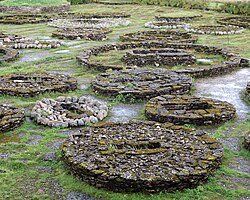
Ancient Estonia[edit]
Humans have settled Estonia since at least 11,000 years ago, based on radiocarbon dating of the Pulli settlement.[4] Human arrival there probably happened shortly after melting the ice left behind by the world's last great glacial era. The people were mostly nomadic, and their lifestyles consisted of activities like hunting and fishing.[5] The ancient people gradually shifted from nomadism to a settled agricultural way of life.
Like elsewhere, the development of agriculture and sedentary living caused the ancient Estonians to become much more warlike. Estonia entered the Iron Age around 700–500 BCE, with weapons and land ownership becoming the norm.[6] Trade contacts with the Roman Empire far to the south allowed the Estonians to import nice things like jewelry and more iron weapons to kill people with. The empire's downfall hit Estonia and the rest of Europe, leading to cultural changes and war. Archaeological evidence indicates that during this period, the Estonian population suffered a calamity that greatly decreased their population.[6] Those left generally congregated in large villages near fortress strongholds for defense. That was probably a very good thing since this was when the Scandinavians built a shitload of boats and started sailing around Europe to loot and kill shit.
Viking age[edit]
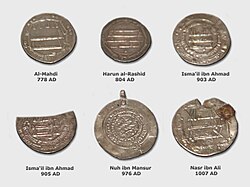
It's known that many Estonians joined the Scandinavians in becoming raiders. In Estonia's case, they seemed to have been motivated by shortages caused by a long period of famine.[7] Thus, the obvious choice was to plunder the much-less martial Christian Europe. Estonian Vikings were referred to as Oeselians, named after the large island of Ösel off the coast of Estonia.[8] They notably launched raids against pagans and Christians, even hitting Scandinavia and making a name for themselves as fearless warriors.
King Ingvar of Sweden apparently feared the Oeselians enough to constantly have his coasts patrolled to fend them off, and they also held a king of Norway as a slave during the man's childhood.[8] The Oeselians also collaborated with other Baltic Viking groups to assault the Swedish city of Sigtuna in 1187, burning the trade hub to the ground and hauling away its goods.[9] Modern Estonians are still quite proud of this because Vikings are cool, and Vikings fighting each other is even cooler.
Still, this was a violent and bloody time, and the Estonian people knew it. Almost all the dozens of forts in Estonia that modern archaeologists know about were built to defend against the Scandinavians.[10] Numerous longship burials have been found in Estonia, along with many hoards of treasure, containing coins from as far off as Italy and Arabia.[8] The Oeselians had apparently taken their trading and adventuring pretty far.
Crusader era[edit]
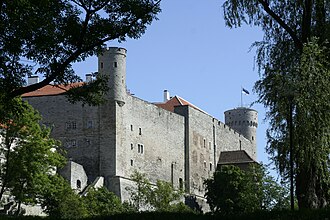
Conquest[edit]
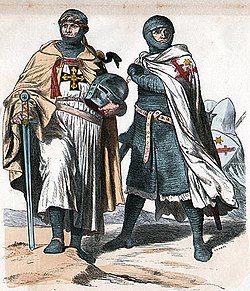
The Estonians kept up their raiding, drawing the ire of Christian Europe. Perhaps even worse than that was that Estonia remained resistant to Christian proselytizing long after most of Scandinavia had relented and converted.[11] In 1199, Pope Innocent III declared a crusade to halt the Estonian raids and convert them to Christianity.[12] Much of the impetus didn't come from the Estonians themselves but from the Catholic desire to expand at the expense of Eastern Orthodoxy, which had been making inroads in places like Belarus and Russia.[13] Denmark also had territorial ambitions against Estonia and thus enthusiastically supported the effort because the Crusades were often just an excuse for conquest. Don't worry; Danish expansion is what God would have wanted.

With papal promises of indulgences and land, the Order of the Sword Brethren stormed into southern Estonia in 1208 to burn and destroy its settlements and begin converting the population by force.[14] Ten bloody years of war ensued with the pagans and Christians massacring and retaliating against each other, and the pagans of southern Estonia finally submitted in 1218. The Oeselians were the last holdouts of the entire Crusade despite coming under repeated Danish assault. They only relented in 1227 but rose again immediately after and massacred the priests and colonists.
The pagan uprisings in 1237 destroyed the Sword Brethren, and their remnants were absorbed into the German-speaking Teutonic Order. The Teutonic knights occupied most of the Baltic region, although northern Estonia was partitioned off to Denmark.[14] While the Germans and Danish served as the exalted ruling class, the Estonians became oppressed serfs.[15] This poor treatment resulted in repeated Estonian uprisings, and in 1345, the constant violence convinced Denmark to hand their part of the region back to the Teutonic Order.
Misrule[edit]

Estonia's large cities, left over from the Viking era and before, became major trade hubs under Teutonic rule. German merchants brought Estonian cities like Tallinn, Tartu, Pärnu, and Narva into the Hanseatic League of the Holy Roman Empire to dominate Baltic shipping routes.[15] All about that cash. Meanwhile, religious orders like the Cistercians and Dominicans converted the Estonian pagans to Christianity through various hastily-conducted baptism rituals.[16] Preachers learned local languages and customs, and members of poverty-enforcing orders like the Dominicans proved much more popular than those of wealthier orders. These Germans became so entrenched that they became something of a distinct ethnic group, Baltic Germans![]() .
.
Despite their original religious quest, the crusader authorities and the actual church officials started to differ in their goals for Estonia. Especially contentious were the Teutonic Order's attempts to require that local bishops be members of its ranks.[17] After all, the crusaders were in it for greed and power more than anything else. The Teutonic Order's interests also inevitably clashed with the Estonian peasantry's. The Estonians faced crushing oppression under serfdom enforced by harsh laws.[17] Their main hope was to escape to one of the Hanseatic cities, which had a low birthrate and thus welcomed escaped peasants to add to their population.
Protestant Reformation[edit]
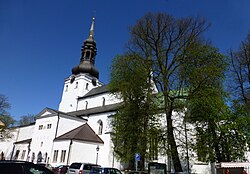
The Protestant Reformation spread quickly throughout the Baltic region despite Catholic efforts to halt it. The long-standing tensions between the towns and the peasants against the Catholic regime meant the population's embracement of Protestantism occurred very quickly.[18] Towns invited Lutheran preachers from elsewhere in Europe, and the rich German burghers used their wealth to spread the message. By 1524, Estonian and burgher frustrations manifested in a wave of iconoclasm that saw many Catholic churches and properties looted by unstoppable angry mobs.[19]
After this, religious life in Estonia changed dramatically, with the old religious orders being curtailed and religious services being given in local languages. In 1525, the Order's grandmaster Walter Von Plettenberg converted himself and the Order to the Lutheran faith.[20] This infuriated the Catholic clergy remaining in the Baltics, as the conversion meant taxes would no longer be paid to the Catholic Church. The ensuing disputes and conflicts terminally weakened the Teutonic Order.
Northern battleground[edit]
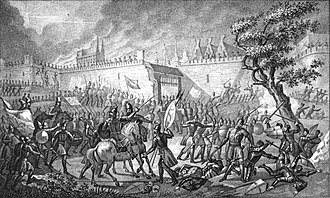
Livonian War[edit]
The Reformation and the internal conflicts it caused catastrophically destabilized the Teutonic Order's regime. Seeing an opportunity to do a little imperialism, Tsar Ivan the Terrible of Russia invaded in 1558.[20] Using the recently-subjugated Central Asian Tatar people as a cavalry spearhead, the Russians pillaged and destroyed the Estonian countryside to weaken the already-staggering crusader regime.[21] The Tatars had no connection to the Baltic people and had no problems committing horrifying atrocities.
Russia's rapid conquest made Poland, Sweden, and Denmark drop a shit in their collective pants. They jointly intervened to save a thankful Teutonic Order, but they naturally started squabbling over the spoils once the Russian threat was no longer immediate. For once, most Estonian inhabitants were pretty unified in deciding that their fellow Lutherans of Sweden would be better overlords than the Catholic Poles and thus voluntarily swore loyalty to Sweden.[21] Poland retaliated by annexing the rest of the Baltics and much of southern Estonia. Denmark also got a nice portion of Estonia, although Sweden took it in 1570 during one of those two countries' fucking endless wars.
Swedish rule (and more war)[edit]

This was far, far from the end of Estonia's agony. Swedish rule was challenged repeatedly by the Russians, who were still very pissed about that whole "ganging up on us" thing. Those wars lasted until well into the 1660s.[21] Sweden also clashed repeatedly with Poland, not just over religious issues but because dynastic marriages had resulted in those countries having very interconnected royal families. Nobody fights like family. The longest bout of fighting started in 1600 and ended almost thirty years later, with Sweden gaining the rest of Estonia.[22] These wars took a horrific toll on Estonia, causing its population to drop by a jaw-dropping 50% between the 1550s and 1630s.[23]
Finally, Sweden intervened in the religious clusterfuck that was the Thirty Years War, which was the final culmination of continent-spanning tensions between Catholics and Protestants (alongside a smaller but just as important "fuck Austria and Spain" movement). The end of this war turned Sweden into an uncontested Baltic power. Unfortunately, they were also flat fucking broke after so many decades of constant war.[24] Sweden's monarch Charles XI decided to deal with this problem by placing more of Sweden's land under his direct control. In 1680, he started confiscating land and property from nobles in Estonia, resulting in more than half of noble property being taken by the Crown.[24] Nobles all over Sweden were furious, but long-oppressed Estonia had one of the most muted reactions.

While the confiscations sucked for the nobles, it was a nice deal for the peasants. Many of them worked for the Crown directly and were paid to help assess the new lands; they were rewarded with various new laws giving them legal rights and preventing abuses.[24] This hopeful era of reforms, like many hopeful eras of reforms, ended abruptly with war and crisis. First came a catastrophic famine in 1699 that killed some 20% of the Estonian population.[25] Then, in 1700 came the Great Northern War, in which Russia, Denmark, Poland, Prussia, and England teamed up to cut Sweden down to size.[26] The Swedes used scorched-earth tactics across Estonia (because Estonia needed to be shit on just a little bit more), but ultimately Russia conquered the region in 1710 and had that conquest confirmed at the end of the war.[27]
Russian imperial rule[edit]
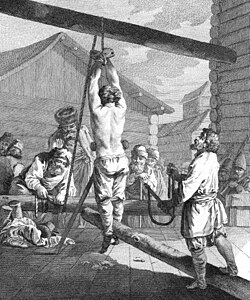
Serfdom and misery[edit]
The Great Northern War was another population catastrophe for Estonians, as Russian brutality and a horrible epidemic reduced the total Estonian population to somewhere around 150,000 people.[28]
The Russian Empire brought a stagnant period to Estonian history. The old German nobility, who had been curtailed under Sweden, were restored their rights and lands. The Estonian people were once again reduced to the status of serfs, and their rights reached the absolute lowest point during this period.[29] Although the Russian Orthodox Church was given free rein to do whatever it wished to Estonia, in practice, Lutheranism remained the dominant religion.
Serfdom, more than anything else, defined this era. Landlords had unlimited power over the property and bodies of their serfs. With much of Estonia's land devastated, the landlords were extremely harsh in driving the Estonian serfs to produce more profit.[30] The primary engine of this profit came from distilling alcohol, which would then be sold to the Russians (of course).[30] While serfs were subject to harsher conditions and brutal labor, the landlords got more and more profit with which to build nicely extravagant mansions.
While the Enlightenment largely bypassed the Estonian serfs, criticisms of serfdom did begin to surface in the late 1700s. Pastor Johann Georg Eisen and writer Garlieb Merkel began petitioning the Russian tsars to abolish serfdom by playing on the Russian fear that the landlords were getting too powerful.[31] Abolitionism was still a long and frustrating process, and it coincided with a much harsher series of requirements on the Estonians for military service.
Rising nationalism[edit]

During the 1800s, Estonia followed the general European trend of rising nationalism among its populace. Estonian intellectuals like newspaper publisher Johann Voldemar Jannsen and schoolmaster Carl Robert Jakobson became leading figures in this national revival movement by promoting Estonian-language publications and founding institutions to further educate the people.[32] The epic poem Kalevipoeg, written by Friedrich Reinhold Kreutzwald based on Ancient Estonian legends, became the foundational piece of Estonian literature.[33] Inevitably, this cultural and educational revival was coupled with public demands for increased rights for Estonians.
Russification[edit]
The Russian Empire did not grant increased rights. Pretty on brand for them. Instead, the Russians embraced their own nationalism and tried to enforce it on the myriad minorities living within their empire. In Estonia, the Russification agenda was especially urgent after the rise of the German Empire in 1870 and the fear that the Estonian German population would feel greater loyalty towards Germany than Russia.[34]
Starting shortly after that, Russian officials began revoking rights from the Germans. This equalized society since the old landlords were now reduced to the same status as the peasants, but this only meant that everyone was treated with equal shittiness by an imported Russian ruling class.[34] The old German landlords had been terrible, but they had at least a working knowledge of the Estonian language and customs. The new Russian ruling class had no desire to learn or conform. The Russians also forced their language onto the education system and local government while suppressing Estonian culture.[35] Estonian teachers were purged from schools for failure to speak the Russian language. This impacted education terribly, with public literacy declining by about 10% between 1886 and 1901.[34] The Russians also hoped to convert the Estonians to the politically-loyal Russian Orthodox Church, a campaign whose limited success was achieved by bribing peasants.
Estonian resistance gradually gained steam due to their own increasing national consciousness, resulting in the Estonians forming a political entity and declaring autonomy and an end to Russification in 1905. The Russians reacted with characteristic brutality, sending in the troops, conducting massacres and mass executions, and deporting many hundreds of Estonians into Siberia.[36]
World War I[edit]

Russia joined the Great War against Germany, which proved to be a catastrophic mistake for them. Estonia served as a crucial part of the Empire's military plan, with Tallinn hosting the Russian Baltic Fleet and with Estonia's landscape being fortified against invasion.[37] Some 100,000 Estonians were conscripted to fight for Russia, and around 10,000 ended up dying for Russia.
Despite the war going pretty badly for Russia, Estonia was spared the burden of hosting the war's destructive land battles until 1917. Of course, the deteriorating Russian economy and the resulting famine, combined with a flood of refugees fleeing the war, made life in Estonia hell. Germany finally invaded Estonia in October 1917, after the February Revolution had swept the Tsar from power.[38] With Russia in total collapse, Estonian soldiers returned home and began forming nationalist brigades in preparation for the inevitable war of independence.
After the Bolshevik coup in the October Revolution, Estonia's nationalist brigades also played a vital role in preventing the communists from taking power there.[37] This failure helped convince Vladimir Lenin to cede Estonia to Germany in the Treaty of Brest-Litovsk and thus make it Germany's problem instead.
Brief independence[edit]

Liberation war[edit]
Estonia finally declared independence in February of 1918, a declaration that Germany promptly refused to recognize.[37] Germany's imperialist intentions were to create a puppet state called the "United Baltic Duchy", which would be ruled by the old class of German landowners who had helped make life miserable there for so long.[39] These plans were ultimately destroyed by the German Revolution and the German armistice (basically a surrender) in November.
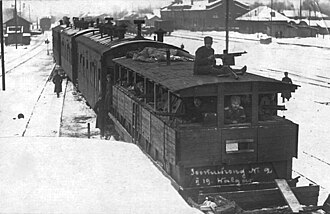
Unfortunately, that wasn't the end of Estonia's problems. Of course. Lenin realized that the German defeat meant that Russia had a chance to get its land back, and the German landowners were still in Estonia and still eager to seize power. Thus began a three-faction war as the Red Army invaded and the Germans in Estonia formed the Baltische Landeswehr to take the country for themselves.[40] The war came at a pretty fucking bad time for the Estonians, who didn't even have a real government yet. They also lacked food, military supplies, professional military officers, and money, all things that would have been nice to have in a war situation.[41] Luckily, Estonia got aid from the United Kingdom, which didn't want to see Estonia fall to the Bolsheviks. Estonia also did a quite impressive job of rapidly assembling their WWI veterans into a military force, although it was helped by the fact that they had prepared for this eventuality. Preparation pays off; a good life lesson.
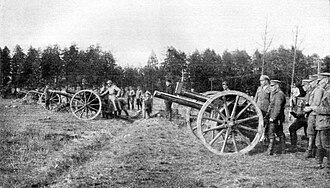
The Bolshevik invasion was overwhelming, and they conquered about half of Estonia by the end of January 1919. However, they were also fighting against independent armies in Poland, Ukraine, and Finland, not to mention the various other factions in the absolute clusterfuck that was the Russian Civil War. This meant the Reds were trying to push along a front that spanned most of Eastern Europe, a failing proposition that saw their armies overstretched and weakened.[42] When Estonia pushed back, they pushed back hard, taking the front line all the way into Russia and seizing the Russian city of Pskov. They also smashed the less-organized Landeswehr between themselves and the Latvian independence army.[41]
With a friendly neighbor to the south and the Soviet war against Poland going remarkably badly, Estonia had basically secured itself by mid-1919. They followed up with some ill-advised attempts against Russia, but the Bolsheviks finally offered to talk in December.[41] By February of 1920, the Soviet Union and the new Estonian state recognized each other and agreed to stop killing each other. Yay, peace.
Parliamentary republic[edit]
In 1920, the Estonians had a state for the first time in history. Estonia's government soon became a parliamentary democracy, the system that the Estonians believed would be best capable of dealing with the competing demands of the Russian, German, and Jewish minority populations.[43] As one of its first major acts, the government confiscated and parceled out the historic estates of the Baltic German nobility, in the process becoming essentially the same monstrosity of injustice they claimed to be correcting.[44] Estonia's economy was largely agricultural, and land reform helped set the country toward greater equality and began belated industrialization.
Estonia and the Soviet Union initially got on pretty well since the Soviets needed a trade outlet with the rest of the world, and the Estonians were still dependent on Russian goods.[43] That era of good feelings ended in 1924 when the Soviets sponsored and supported a communist coup attempt against the government.[45] The failed coup pushed Estonia towards the West and killed domestic support for communist ideas.
Dictatorship[edit]

Parliamentary democracy ended largely thanks to the Great Depression, which radicalized a good portion of the Estonian population. With communism largely discredited and feared due to being represented by the Soviet Union, Estonian radicals turned instead to an ideology similar to fascism. The so-called League of Independence War Veterans (also called the Vaps movement) and politician Konstantin Päts proposed scrapping the parliament and instead implementing a system with a strong president who would be able to handle the economic challenges.[46] The measure passed by referendum and empowered Päts as the new Estonian president.
Päts and his political allies promptly turned against the Vaps, accusing them of plotting to take power and launching an internal coup in 1934.[47] Incidentally, he banned political parties and placed all government offices under his direct control. The new regime enacted extensive censorship and surveillance measures against anyone who opposed it. This was legal under a perpetual state of emergency, a typical tool in the authoritarian handbook. However, the regime of Päts was quite mild compared to, for example, the regimes of the USSR, Nazi Germany and fascist Italy at that time.
Soviet rule[edit]

We're back, bitches![edit]
The Päts regime was cut short by Stalin, who had seized power in the Soviet Union and proved a much more effective and bloodthirsty autocrat than Päts could hope to be. Stalin was also an unashamed imperialist who hoped to regain the old Russian Empire's territory, starting with the Baltic countries. In 1939, Stalin struck the Molotov-Ribbentrop Pact with his friends in Nazi Germany, slicing Eastern Europe into spheres of influence and assigning Estonia to the Soviets.[48] Under the pact's terms, the Soviets and Germans jointly attacked Poland, beginning World War II and dismembering that sorry country.
Estonia tried to save itself by declaring neutrality and pointedly not preparing for an invasion.[49] It, uh, didn't work. Stalin arm-twisted the Baltic states into signing "pacts of mutual assistance", which would allow Soviet military presence within their borders. After what had happened to Poland, there was an implicit threat. Estonia folded, and so did the Soviets, in that they folded Estonia into their country.
A side-effect of Estonia's annexation was the mass resettlement of many Baltic Germans into Nazi Germany, a program called the Umsiedlung.[50] The resettlement was meant to help Germany colonize occupied Poland and the other German conquests.
The Soviets cracked down brutally on Estonia, conducting massacres and deporting some 11,000 people into Siberia, many of whom died in the brutal gulags.[51]
German invasion[edit]

While the Soviets were bad news, Nazi Germany was even fucking worse. Ever the rabid expansionist, Adolf Hitler sent his hordes to assault the Soviet Union in 1941, beginning one of the worst conflicts in human history. The Soviets reacted by treating Estonia even worse, conscripting thousands of people into forced labor battalions and tens of thousands to die for the union they had joined at the point of a gun.[52]
Many Estonians hoped, at first, welcomed the German invasion as the end of Soviet colonialism, and hoped that Estonia would regain its independence with the Soviets having been driven out. The Nazis, of course, quickly destroyed those hopes, and made all of Stalin's terribleness look like child's play. They incorporated occupied Estonia into a planned colonial regime called the Reichskommissariat Ostland as part of their plan to eliminate those they found undesirable and forcibly assimilate "racially suitable" Estonians.[52] After this horrific genocide, Germany would colonize the region with their own people. While that plan was never carried out in full, the Nazis ruled the roost there long enough to conduct some horrific crimes against humanity. As part of the implementation of the Holocaust, the Waffen-SS and other German forces massacred Jews across Estonia, virtually eliminating all of the Jews who had failed to flee in time.[53] They even had time to build the Klooga concentration camp, a facility that resulted in the murders of at least 2,000 people through starvation and forced labor.[54]
Despite the Nazi German horrors, Estonians fought for both sides in the war, with some even complicit in the massacres of Jews.[53] Other Estonians fled to Finland, where they helped that country defend itself against the Soviets.[55] Beyond hiding their relatives and friends from German murder, Estonians did little to fight against the German occupation, still seeing the Soviet Union as their primary foe.[56]
The Soviet return to Estonia in 1944 was marked by heavy fighting as the stubborn Germans clung on for dear life. The Battle of Narva lasted six months, with heavy destruction and hundreds of thousands of casualties.[57] The Soviet air force also indiscriminately bombed Tallinn and other Estonian towns and cities, destroying much of the state's infrastructure and causing many Estonian deaths.[58]
In World War II, Estonia lost about 25% of its population through deaths, deportations, and evacuations.[59] Many Estonians chose to flee west as refugees rather than resume living under Soviet domination.
More brutality and misery[edit]
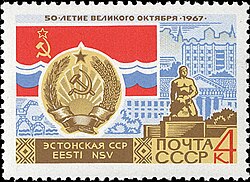
While some Estonians fled, others became the "Forest Brothers", who fought a low-intensity partisan war against the Soviet occupiers for the better part of a decade after WWII.[60] The Soviets gradually wore down the resistance movement through attrition and brutality. The Soviets used this as an excuse to unleash a wave of terror against Estonia after the war, deporting another 20,000 people into Siberian gulags and then completing agricultural collectivization in their absence.[61]

Collectivization combined with forced industrialization finally started to bring Estonia's economy up to modern standards, although this was accomplished through misery and death. Despite Soviet attempts at suppressing knowledge, the Estonians became aware of how much lower their standard of life compared to the Western world, thanks to missives from their relatives who had fled west and their proximity to Finland.[62] The development of heavy industry also progressed with no concern for the environment, resulting in heavy pollution.[63]
In response to persistent Estonian disloyalty, the Soviet Union launched its version of the Russification policies, sending many ethnic Russians to Estonia in the hopes of turning it into a Russian colony.[64] The Soviets also turned much of Estonia into a fortified military outpost against the west.[65]
Slow revival[edit]
Internal opposition increased as the Estonian economy stagnated along with the rest of the Eastern Bloc. Mikhail Gorbachev's openness reforms starting in 1987 finally gave the Estonians an opportunity to voice their displeasure. This began almost immediately with large-scale protests against opening a massive phosphorite mine in northern Estonia, a project that would have caused much environmental carnage and attracted even more migrants from the rest of the Soviet Union.[66] This was the first crack that started to bring down the Soviet regime in Estonia.
Public demonstrations also began under the leadership of the Estonian Group on Publication of the Molotov-Ribbentrop Pact, which published the secret protocol of the agreement with Nazi Germany that allowed the Soviets to take over in the first place.[67] Public anger towards these issues combined with a general desire to see the economy improve, a goal the Estonians felt could only be achieved if they could be responsible for their own country. The Estonian population became politically active against the Soviet government.
Anti-Soviet actions[edit]
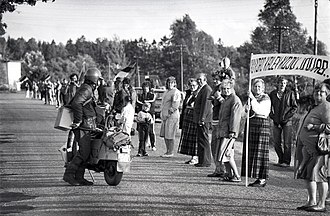
The protest movement reached its peak during the Estonian Song Festival, a spontaneous gathering outside the bounds of the event that involved singing and protest.[68] Hence the name, the "Singing Revolution." Hoping to calm things down, Gorbachev replaced the old Estonian SSR leader with the progressive Vaino Väljas, who promptly started declaring Estonia's sovereignty within the union and adopting the old Estonian national flag.[69] Much of the Russian-speaking Estonian population rallied against the moves, wanting instead to remain in the USSR and thus with their Russian brethren.
Despite the Russian protests, 1989 saw the Baltic Way protests in commemoration of the Molotov-Ribbentrop Pact, as people from all three Baltic republics joined in a massive human chain as an act of protest.[70] By 1990, Estonia's Supreme Soviet had acknowledged that the people's will was to see the old republic restored. The Popular Front party had been swept into the Estonian Supreme Soviet amid the fracturing of the Estonian Communist Party and the beginning of free elections. The Popular Front started pushing for independence while rejecting any prospects of remaining in the USSR.[69]
Estonia finally told the Soviets to go fuck off in the spring of 1990, alongside its fellow Baltic Soviet republics.[71] Estonia luckily avoided the violence that came to Lithuania and Latvia when Soviet troops tried to storm their capital cities. Amid the crisis, Estonia held an independence referendum and officially declared independence in 1991. Amid the political crisis caused by the failed coup attempt in Moscow in August, all of the Soviet republics broke free amid the total collapse of the old Soviet Union, allowing Estonia's independence to be uncontested.[71]
Independent era[edit]
.jpg)
Reforms[edit]
After achieving its independence, Estonia began a path of radical economic reform designed to transition the country into a market economy.[72] Many businesses were privatized, and Estonia reestablished its old currency from the 1930s, the kroon. Estonia's reforms achieved remarkable success compared to its fellow Baltic states, especially the misery that befell Russia during this time. Much of this is attributable to the decision of the Estonian government and industrial leaders to focus the country on the technology sector, upgrading communications networks and offering incentives to internet startups.[73] Estonia's hard early years were also softened by the proximity of Finland, where many Estonians could work and bring back earnings.
On the other hand, according to the World Bank, the poverty headcount skyrocketed from 1% to 37% from 1987-1988 to 1993-1995, worse than its two neighbors, Latvia (1% to 22%) and Lithuania (1% to 30%), but still much better than Russia (2% to 50%) and Ukraine (2% to 63%).[74]:68 Poverty rates among workers were lower than the national average from 1992-1995, while those among pensioners, farmers, and self-employed were higher, though the last might be due to differences in what qualities as "self-employed".[74]:92-94 On the flip side, poverty was comparatively "shallow", in that average income for the poor was not too far below the poverty line, though this is what generally happens when poverty becomes more widespread.[74]:76-77 The institution chalked the increase in poverty in Estonia and other transition economies to decline in population incomes and increase in income inequality[74]:85-92
Western foreign policy[edit]
Estonia also pursued close ties with the West, joining the European Union and NATO in 2004.[75] This also resulted in Estonia ditching its short-lived currency and taking up the Euro.
Estonia soon proved its commitment to its allies by sending a significant force to participate in the harshest theatres of the Afghanistan War[76] and then briefly sending another contingent to fight in the Iraq War.[77] Even after that, Estonia maintained a small training force in Iraq until 2020.[78] Estonia suffered 9 deaths in Afghanistan[79] and 2 deaths in Iraq.[80]
The country is one of the most committed to the NATO alliance, as shown by its participation in operations. Much of that is motivated by fear of the threat of Vladimir Putin and his expansionist Russia. Estonia has mandatory military service for its healthy men and has repeatedly hiked up its military budget.[81] Estonia has a population motivated for defense and extensive defense preparations, and many of its people consider an invasion inevitable.[82]
Religion[edit]

Christianity[edit]
The main religion of Estonia since the beginning of the 13th century has been Christianity. Until the 16th century, it was Catholicism, and after the reformation initiated by Martin Luther, Lutheranism. Lutheranism, despite its declining influence today, has significantly influenced the development of Estonian culture. Besides this, the Eastern Orthodox Church has been widespread in the eastern regions since the middle of the 19th century, and its distribution was also part of the policy of the tsarist authorities. Besides this, other Protestant denominations have also spread over the centuries. In the 18th century, in addition to Lutheranism, the Moravian Church also spread among the peasants. In the 19th century, several Protestant sects were popular, for example (the Maltsvetians). Freed from the pressure of Soviet state atheism during the years of Estonia's re-independence, the Lutheran Church was able to temporarily gain greater popularity and many clergy were active during the so-called singing revolution.
Atheism[edit]
“”Even in schools religion does not feature on the curriculum in its own right. Instead, in history lessons, young Estonians learn about the waves of invasion led by the Germans and Danes who brought Christianity to the country. It came to be seen as the faith of the colonisers, one rejected by the majority.
|
| —Tom Esslemont, BBC News.[83] |
Estonia's population has rejected organized religion to a startling degree, with only 29% adhering to any religion and even fewer regularly participating.[84][85] Perhaps that's due to the country's tragic history. Of those who are religious, almost all of them are either Lutheran or Eastern Orthodox.[86]
According to the constitution, there is freedom of religion, no state church, and every person has the right to privacy of belief and religion. Estonia is believed to be the most atheistic country in the world,[87] with over 76% of the population stating no specific religious affiliation.[88] According to Eurobarometer Poll 2005, 26% of the population said that "they do not believe there is any sort of spirit, god, or life force".[89]
Estonia's non-religious attitude can be seen as an extension of the country's resistance to the Teutonic crusaders, who forced Christianity upon the unwilling pagans.[90] Estonians, in general, pride themselves on being unattached to religion, and most of the country's practitioners of Christianity are from the Russian population.[90]
Neopaganism[edit]
Estonia also sees a rising neo-pagan movement attempting to revive the old traditions that Estonia had before the conquest by the Crusaders, largely motivated by Estonian nationalism. One of the first to pop up was Taaraism, which focused on honoring nature through worshiping the indigenous Estonian gods.[90][91] Taaraism takes a monotheistic approach to religion, claiming that the old Estonian gods were and are just various aspects of an all-encompassing deity. It began during Estonia's brief independence after World War I, but it was harshly and murderously suppressed by the Soviet Union due to its emphasis on Estonian national identity.
Another movement is the Maausk religion, meaning "Earth belief." This variant focuses on nature, with rituals involving sacred groves in forests, bonfire ceremonies, and gifts of eggs and ribbons.[92] Maausk followers also emphasize culture and tradition, with notable follower Ahto Kaasik explaining that Maausk is "our vernacular, our songs, our customs, our beliefs, our archetypes and culture... a tradition that binds us to our land."[93]
As interesting as these movements are, they're still quite small in Estonia, although growing fairly quickly.[90] Their rising popularity benefits from the decrease in religiosity, as Estonians wish to identify with their ancestors and traditions rather than the Christian religion.
Gallery[edit]
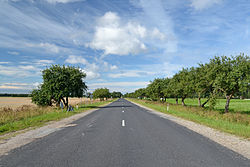
Landscape in the countryside.
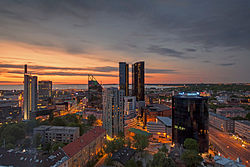
Business district of Tallinn.

Estonian pastries.
Coastal wind farm.

Estonian woman at a folk festival.
.jpg)
Estonian Song Festival in Tallinn.
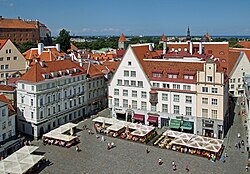
The old town of Tallinn is full of tourists.
References[edit]
- ↑ See the Wikipedia article on Estonian Declaration of Independence.
- ↑ Yanatma, Servet (2024-03-08). "Gender pay gap: Only one country in Europe pays women more than men". euronews. Retrieved 2024-05-21.
- ↑ ERR, ERR News (2022-11-30). Daily: Commission report cites slow Estonian internet, telecoms blame state "Daily: Commission report cites slow Estonian internet, telecoms blame state". ERR. Retrieved 2024-05-21.
{{cite web}}: Check|url=value (help) - ↑ See the Wikipedia article on Pulli settlement.
- ↑ Subrenat, Jean-Jacques (2004). Estonia: Identity and Independence. Rodopi. p. 23. ISBN 9042008903.
- ↑ 6.0 6.1 The Iron Age. Estonica: Encyclopedia about Estonia.
- ↑ Vikings in Estonia. Viking Network.
- ↑ 8.0 8.1 8.2 The Vikings of the Baltic Sea. Baltic Run.
- ↑ Sigtuna Burned to the Ground in 1187. The History Files.
- ↑ Tvauri, Andres (2012). The migration period, pre-viking age, and viking age in Estonia. ISBN 9789949199365. p. 46
- ↑ Foreign conquest and formation of a new administrative division. Estonica: Encyclopedia about Estonia.
- ↑ Tyerman, Christopher (2006). God's War: A New History of the Crusades. Harvard University Press. p. 690. ISBN 9780674023871.
- ↑ Crusaders of the Baltic Shore. The Postgrad Chronicles.
- ↑ 14.0 14.1 Estonia, Duchy of. Erenow.
- ↑ 15.0 15.1 Estonia: Early History. Country Studies.
- ↑ Spread of Christianity and religious orders. Estonica: Encyclopedia about Estonia.
- ↑ 17.0 17.1 Internal affairs in 15th century Old Livonia: nobility, clergy and peasantry. Estonica: Encyclopedia about Estonia.
- ↑ Frucht, Richard C. (2005). Eastern Europe: An Introduction to the People, Lands, and Culture, Volume 1. ABC-CLIO. p. 121. ISBN 9781576078006.
- ↑ Religious life in the late Middle Ages. The Reformation. Estonica: Encyclopedia about Estonia.
- ↑ 20.0 20.1 Protestant Reformation in the Baltic.
- ↑ 21.0 21.1 21.2 Swedish, Danish, Russian and Polish-Lithuanian wars for Estonia. Estonica: Encyclopedia about Estonia.
- ↑ Raun, Toivo U. (2002). Estonia and the Estonians: Second Edition, Updated. Hoover Press. p. 28. ISBN 9780817928537.
- ↑ Frost, Robert I. (2014). The Northern Wars: War, State and Society in Northeastern Europe, 1558 – 1721. Routledge. p. 77. ISBN 9781317898573.
- ↑ 24.0 24.1 24.2 Estonia during the reign of the absolutist King Charles XI. The Great Reduction of manors. Estonica: Encyclopedia about Estonia.
- ↑ Raun, Toivo U. (2002). Estonia and the Estonians: Second Edition, Updated. Hoover Press. p. 31. ISBN 9780817928537.
- ↑ See the Wikipedia article on Great Northern War.
- ↑ The Great Northern War. End of Swedish rule in Estonia. Estonica: Encyclopedia about Estonia.
- ↑ Population: ethnic and social structure. Estonica: Encyclopedia about Estonia.
- ↑ Raun, Toivo U. (2002). Estonia and the Estonians: Second Edition, Updated. Hoover Press. p. 41. ISBN 9780817928537.
- ↑ 30.0 30.1 Serfdom and the intensifying manorial economy. Estonia and the Estonians: Second Edition, Updated. Hoover Press. p. 41. ISBN 9780817928537.
- ↑ Enlightenment and enlightened absolutism. Estonia and the Estonians: Second Edition, Updated.
- ↑ Subrenat, Jean-Jacques (2004). Estonia: Identity and Independence. Rodopi. p. 93. ISBN 9042008903.
- ↑ See the Wikipedia article on Kalevipoeg.
- ↑ 34.0 34.1 34.2 Russification period. Estonica: Encyclopedia about Estonia.
- ↑ Cultural Policy in Estonia. Council of Europe. 1997. p. 23. ISBN 9789287131652.
- ↑ Smith, David (2013). Estonia: Independence and European Integration. Routledge. p. 10. ISBN 9781136452130.
- ↑ 37.0 37.1 37.2 World War I. Estonica: Encyclopedia about Estonia.
- ↑ See the Wikipedia article on Operation Albion.
- ↑ United Baltic Duchy. Estonica: Encyclopedia about Estonia.
- ↑ See the Wikipedia article on Baltische Landeswehr.
- ↑ 41.0 41.1 41.2 Estonian War of Independence. Estonica: Encyclopedia about Estonia.
- ↑ Raun, Toivo U.: Estonia and Estonians, page 108. Hoover Press, 2001, ISBN 9780817928520
- ↑ 43.0 43.1 Years of parliamentarian democracy. Estonica: Encyclopedia about Estonia.
- ↑ Estonia: Interwar Independence, 1918-40. Country Studies.
- ↑ An attempted Communist coup d’état on 1 December 1924. Estonica: Encyclopedia about Estonia.
- ↑ Years of the Great Depression. Estonica: Encyclopedia about Estonia.
- ↑ Years of the authoritarian regime. Estonica: Encyclopedia about Estonia.
- ↑ See the Wikipedia article on Molotov–Ribbentrop Pact.
- ↑ Molotov-Ribbentrop Pact and Soviet military bases. Estonica: Encyclopedia about Estonia.
- ↑ Umsiedlung. Estonica: Encyclopedia about Estonia.
- ↑ Miljan, Toivo (2015). Historical Dictionary of Estonia. Rowman & Littlefield. p. 110. ISBN 978-0-8108-7513-5.
- ↑ 52.0 52.1 Estonia. World War II Database.
- ↑ 53.0 53.1 Estonia. US Holocaust Memorial Museum.
- ↑ See the Wikipedia article on Klooga concentration camp.
- ↑ Miljan, Toivo (2004). Historical Dictionary of Estonia. Scarecrow Press. p. 275. ISBN 978-0-8108-6571-6.
- ↑ German occupation in Estonia 1941-1944. Estonica: Encyclopedia about Estonia.
- ↑ See the Wikipedia article on Battle of Narva (1944).
- ↑ Kangilaski, Jaan; Salo, Vello (2005). The white book: losses inflicted on the Estonian nation by occupation regimes, 1940–1991. Estonian Encyclopaedia Publishers. p. 18. ISBN 9789985701959.
- ↑ Kangilaski, Jaan; Salo, Vello (2005). The white book: losses inflicted on the Estonian nation by occupation regimes, 1940–1991. Estonian Encyclopaedia Publishers. p. 37. ISBN 9789985701959.
- ↑ See the Wikipedia article on Forest Brothers.
- ↑ Purs, Aldis (2013). Baltic Facades: Estonia, Latvia and Lithuania since 1945. Reaktion Books. p. 335. ISBN 9781861899323.
- ↑ The command economy and its consequences. Estonica: Encyclopedia about Estonia.
- ↑ Miljan, Toivo (2015). Historical Dictionary of Estonia. Rowman & Littlefield. p. 227. ISBN 9780810875135.
- ↑ Taagepera, Rein (2013). The Finno-Ugric Republics and the Russian State. Routledge. p. 128. ISBN 9781136678011.
- ↑ Spyra, Wolfgang; Katzsch, Michael (2007). Environmental Security and Public Safety: Problems and Needs in Conversion Policy and Research after 15 Years of Conversion in Central and Eastern Europe. Springer Science & Business Media. p. 14. ISBN 9781402056444.
- ↑ See the Wikipedia article on Phosphorite War.
- ↑ The first changes. Estonica: Encyclopedia about Estonia.
- ↑ See the Wikipedia article on Singing Revolution.
- ↑ 69.0 69.1 Breakthrough Years. Estonica: Encyclopedia about Estonia.
- ↑ See the Wikipedia article on Baltic Way.
- ↑ 71.0 71.1 The road to independence. Estonica: Encyclopedia about Estonia.
- ↑ Ó Beacháin, Donnacha; Sheridan, Vera; Stan, Sabina (2012). Life in Post-Communist Eastern Europe after EU Membership. Routledge. p. 170. ISBN 9781136299810.
- ↑ Estonia: What Is Behind Economic Success? Radio Free Europe.
- ↑ 74.0 74.1 74.2 74.3 Milanovic, Branko. (January 1998) Income, Inequality, and Poverty during the Transition from Planned to Market Economy, World Bank DOI:10.1596/1813-9450-1935
- ↑ Miljan, Toivo (2015). Historical Dictionary of Estonia. Rowman & Littlefield. pp. 18–19. ISBN 9780810875135.
- ↑ Tiny Estonia keen to make large contribution in Afghanistan fight. Stars and Stripes.
- ↑ Estonia's 34 troops withdrawn from Iraq. CNN.
- ↑ Defense minister: Estonian soldiers' work in Iraq has been suspended.
- ↑ See the Wikipedia article on Coalition casualties in Afghanistan.
- ↑ See the Wikipedia article on Casualties of the Iraq War § Coalition military casualties.
- ↑ See the Wikipedia article on Estonia § Military.
- ↑ ‘They will die in Tallinn’: Estonia girds for war with Russia. Politico EU.
- ↑ Spirituality in Estonia - the world's 'least religious' country. BBC News.
- ↑ Is Estonia really the least religious country in the world?. The Guardian.
- ↑ Estonians least religious in the world. EU Observer.
- ↑ See the Wikipedia article on Religion in Estonia.
- ↑ The least religious nation in the world is Estonia
- ↑ Archive copy at the Wayback Machine Statistical database: Population Census 2000 – Religious affiliation]
- ↑ "Eurobarometer on Social Values, Science and technology 2005"
- ↑ 90.0 90.1 90.2 90.3 Estonians – the nation of neo-Pagans? Estonian World.
- ↑ See the Wikipedia article on Estonian neopaganism.
- ↑ Soviet power gone, Baltic countries’ historic pagan past re-emerges. Religion News Service.
- ↑ Baltic diaspora and the rise of Neo-Paganism. The Baltic Times.
Categories: [Member states of the European Union] [European countries] [NATO member states]
↧ Download as ZWI file | Last modified: 11/08/2025 03:43:32 | 100 views
☰ Source: https://rationalwiki.org/wiki/Estonia | License: CC BY-SA 3.0


 KSF
KSF